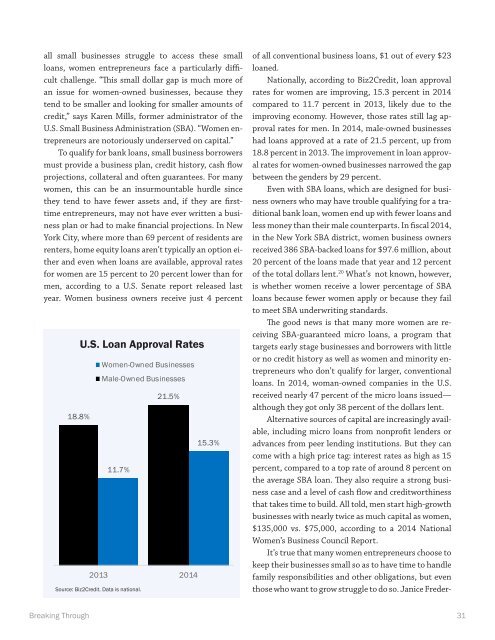BREAKING THROUGH
YWkgl
YWkgl
Create successful ePaper yourself
Turn your PDF publications into a flip-book with our unique Google optimized e-Paper software.
all small businesses struggle to access these small<br />
loans, women entrepreneurs face a particularly difficult<br />
challenge. “This small dollar gap is much more of<br />
an issue for women-owned businesses, because they<br />
tend to be smaller and looking for smaller amounts of<br />
credit,” says Karen Mills, former administrator of the<br />
U.S. Small Business Administration (SBA). “Women entrepreneurs<br />
are notoriously underserved on capital.”<br />
To qualify for bank loans, small business borrowers<br />
must provide a business plan, credit history, cash flow<br />
projections, collateral and often guarantees. For many<br />
women, this can be an insurmountable hurdle since<br />
they tend to have fewer assets and, if they are firsttime<br />
entrepreneurs, may not have ever written a business<br />
plan or had to make financial projections. In New<br />
York City, where more than 69 percent of residents are<br />
renters, home equity loans aren’t typically an option either<br />
and even when loans are available, approval rates<br />
for women are 15 percent to 20 percent lower than for<br />
men, according to a U.S. Senate report released last<br />
year. Women business owners receive just 4 percent<br />
18.8%<br />
U.S. Loan Approval Rates<br />
2013<br />
11.7%<br />
Source: Biz2Credit. Data is national.<br />
Women-Owned Businesses<br />
Male-Owned Businesses<br />
21.5%<br />
2014<br />
15.3%<br />
of all conventional business loans, $1 out of every $23<br />
loaned.<br />
Nationally, according to Biz2Credit, loan approval<br />
rates for women are improving, 15.3 percent in 2014<br />
compared to 11.7 percent in 2013, likely due to the<br />
improving economy. However, those rates still lag approval<br />
rates for men. In 2014, male-owned businesses<br />
had loans approved at a rate of 21.5 percent, up from<br />
18.8 percent in 2013. The improvement in loan approval<br />
rates for women-owned businesses narrowed the gap<br />
between the genders by 29 percent.<br />
Even with SBA loans, which are designed for business<br />
owners who may have trouble qualifying for a traditional<br />
bank loan, women end up with fewer loans and<br />
less money than their male counterparts. In fiscal 2014,<br />
in the New York SBA district, women business owners<br />
received 386 SBA-backed loans for $97.6 million, about<br />
20 percent of the loans made that year and 12 percent<br />
of the total dollars lent. 20 What’s not known, however,<br />
is whether women receive a lower percentage of SBA<br />
loans because fewer women apply or because they fail<br />
to meet SBA underwriting standards.<br />
The good news is that many more women are receiving<br />
SBA-guaranteed micro loans, a program that<br />
targets early stage businesses and borrowers with little<br />
or no credit history as well as women and minority entrepreneurs<br />
who don’t qualify for larger, conventional<br />
loans. In 2014, woman-owned companies in the U.S.<br />
received nearly 47 percent of the micro loans issued—<br />
although they got only 38 percent of the dollars lent.<br />
Alternative sources of capital are increasingly available,<br />
including micro loans from nonprofit lenders or<br />
advances from peer lending institutions. But they can<br />
come with a high price tag: interest rates as high as 15<br />
percent, compared to a top rate of around 8 percent on<br />
the average SBA loan. They also require a strong business<br />
case and a level of cash flow and creditworthiness<br />
that takes time to build. All told, men start high-growth<br />
businesses with nearly twice as much capital as women,<br />
$135,000 vs. $75,000, according to a 2014 National<br />
Women’s Business Council Report.<br />
It’s true that many women entrepreneurs choose to<br />
keep their businesses small so as to have time to handle<br />
family responsibilities and other obligations, but even<br />
those who want to grow struggle to do so. Janice Freder-<br />
Breaking Through 31


